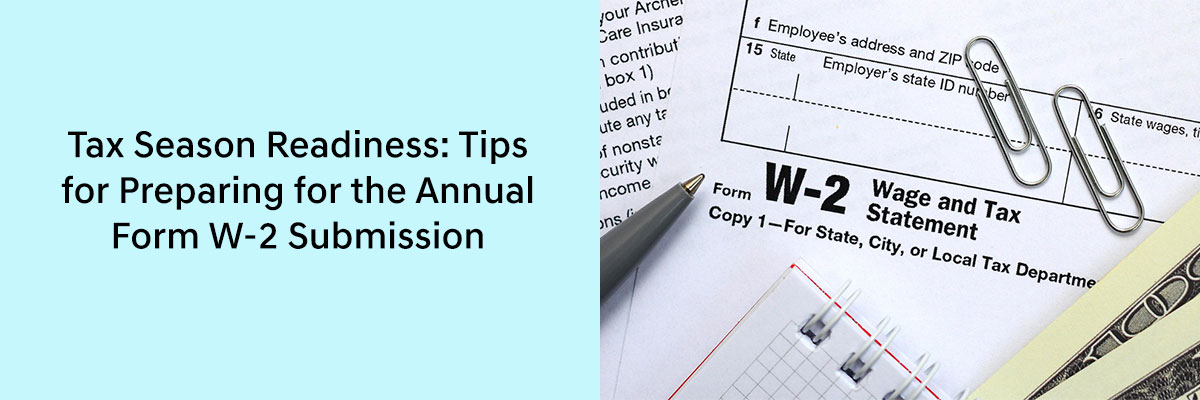The arrival of tax season can be both a daunting and crucial time of the year for individuals and businesses alike. When preparing for the year end and the new year it is a period marked by paperwork, deadlines, filling for taxes, and the need for meticulous financial record-keeping. One of the essential elements of tax preparation for employees and employers is the annual Form W-2 submission.
In this blog post, we’ll explore what Form W-2 is, and its significance, and provide some tips to ensure you’re ready for tax season.
Understanding Form W-2
Form W-2, officially known as the “Wage and Tax Statement,” is a crucial document that provides a summary of an employee’s earnings and tax withholdings throughout the year. Employers are required to issue Form W-2 to their employees by the end of January, which includes information on:
- Wages and Salary: This section reports your total earnings from your employer, including regular wages, tips, and any other forms of compensation.
- Tax Withholdings: It specifies the total amount of federal, state, and local income taxes withheld from your paycheck over the year.
- Social Security and Medicare: Form W-2 also records the amount of Social Security and Medicare taxes withheld from your income.
- Other Benefits: Any additional benefits, such as retirement plan contributions, health insurance premiums, and dependent care benefits, may also be included.
- Employer Information: The form contains your employer’s details, including their name, address, and Employer Identification Number (EIN).
Why Form W-2 Matters
Form W-2 serves several critical purposes for both employees and the government:
- Income Reporting: It helps employees report their annual income accurately to the IRS, ensuring compliance with tax regulations.
- Tax Refunds: Form W-2 is essential for individuals seeking tax refunds. It determines whether you’ve overpaid or underpaid your taxes throughout the year.
- Social Security Benefits: The Social Security Administration uses the information on Form W-2 to calculate retirement benefits for eligible individuals.
- Verification: Employers use Form W-2 to verify the identity and income of their employees, which is crucial for various HR and financial processes.
Now that we understand the significance of Form W-2 let’s delve into some practical tips to help you prepare for its submission during tax season.
Tips for Preparing for Form W-2 Submission
1. Keep Track of Pay Stubs:
Throughout the year, retain your pay stubs or any documentation detailing your income, taxes withheld, and any other deductions. These records will be invaluable when you cross-reference them with your Form W-2 for accuracy.
2. Verify Personal Information:
Ensure that your personal information, such as your name, Social Security Number, and address, matches the details on your Form W-2. Any discrepancies could lead to delays or issues with your tax return.
3. Report All Income:
Remember to report all sources of income, even if you have multiple jobs or receive income from non-employment sources (e.g., freelance work, investments). Accurate reporting is crucial to avoid penalties and audits.
4. Check for Errors:
Review your Form W-2 carefully for any errors in the reported income or tax withholdings. If you spot discrepancies, contact your employer promptly to rectify the issue.
5. File on Time:
Respect the tax filing deadline, which is typically April 15th for most individuals. Filing late can result in penalties and interest charges, so make sure you submit your tax return on time.
6. Explore Tax Deductions and Credits:
Take advantage of available tax deductions and credits to reduce your tax liability. Common deductions include student loan interest, mortgage interest, and contributions to retirement accounts.
7. Seek Professional Help:
If your financial situation is complex, or if you’re unsure about tax laws, consider consulting a tax professional or using tax preparation software. They can help ensure you maximize your deductions and file accurately.
8. Save a Copy:
Always keep a copy of your completed tax return and supporting documents for at least three years. This is essential for reference in case of audits or disputes.
Final words:
Form W-2 is a vital document that plays a pivotal role in tax season. Being prepared and organized can save you time, reduce stress, and help you make the most of available tax benefits. By following these tips and staying informed about tax regulations, you’ll be better equipped to navigate the tax season successfully and submit your Form W-2 accurately and on time.


